
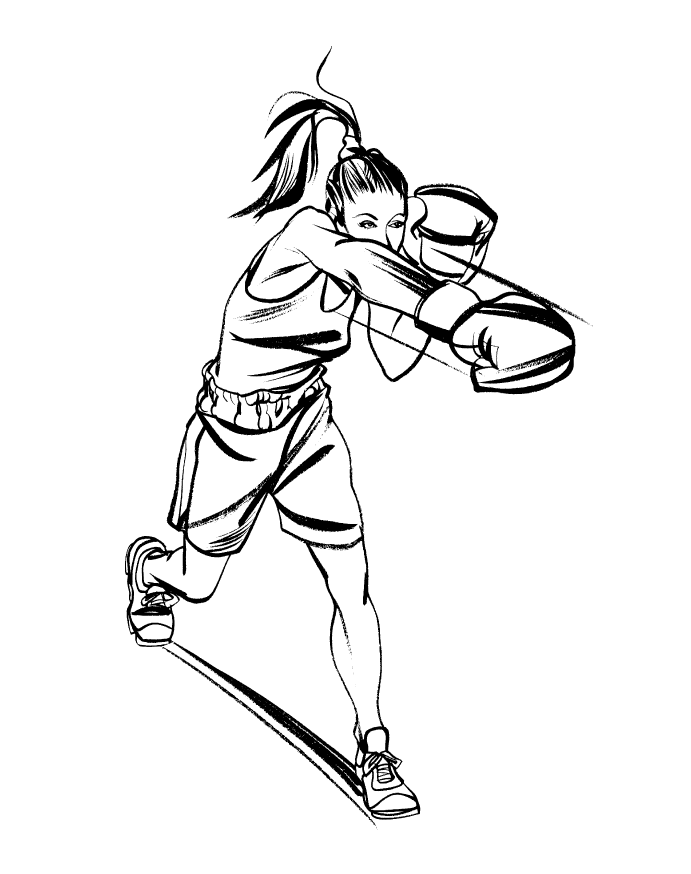
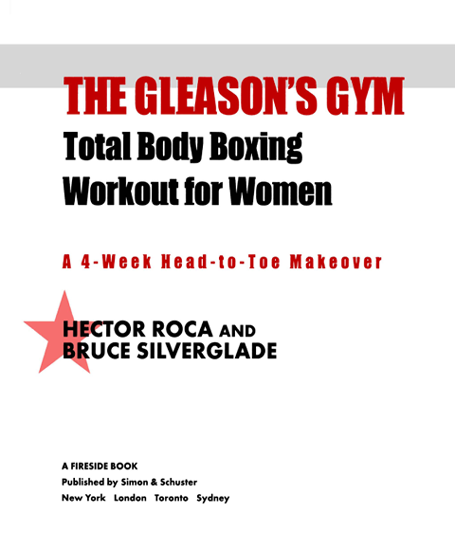

FIRESIDE
Rockefeller Center
1230 Avenue of the Americas
New York, NY 10020
www.SimonandSchuster.com
Copyright 2006 by Hector Roca and Bruce Silverglade
All rights reserved, including the right of reproduction in whole or in part in any form.
FIRESIDE and colophon are registered trademarks of Simon & Schuster, Inc.
Designed by Jaime Putorti
Interior photographs by Frank Veronsky
Interior illustrations by David Lee / The Studio NYC
Manufactured in the United States of America
10 9 8 7 6 5 4 3 2 1
Library of Congress Cataloging-in-Publication Data
Roca, Hector.
The Gleasons Gym : total body boxing workout for women : a 4 week head-to-toe makeover / Hector Roca and Bruce Silverglade
p. cm.
1. BoxingTraining. 2. Physical fitness. I. Silverglade, Bruce. II. Title.
GV1137.6.R63 2006
796.83dc22
2006048308
ISBN-10 0-7432-8687-1
ISBN-13: 978-0-743-28687-9
eISBN: 978-1-439-10363-0
For information regarding special discounts for bulk purchases, please contact Simon & Schuster Special Sales at 1-800-456-6798 or business@simonandschuster.com.
Dedication
 I want to dedicate this workout book to Gleasons Gym and its wonderful tradition and history.
I want to dedicate this workout book to Gleasons Gym and its wonderful tradition and history.
Hector Roca
 I want to dedicate this workout book to the great guys that made Gleasons Gym what it is today: Bobby Gleason and Ira Becker. And of course to my wonderful and loving wife, JoEllen VanOuwerkerk, who is my real inspiration.
I want to dedicate this workout book to the great guys that made Gleasons Gym what it is today: Bobby Gleason and Ira Becker. And of course to my wonderful and loving wife, JoEllen VanOuwerkerk, who is my real inspiration.
Bruce Silverglade
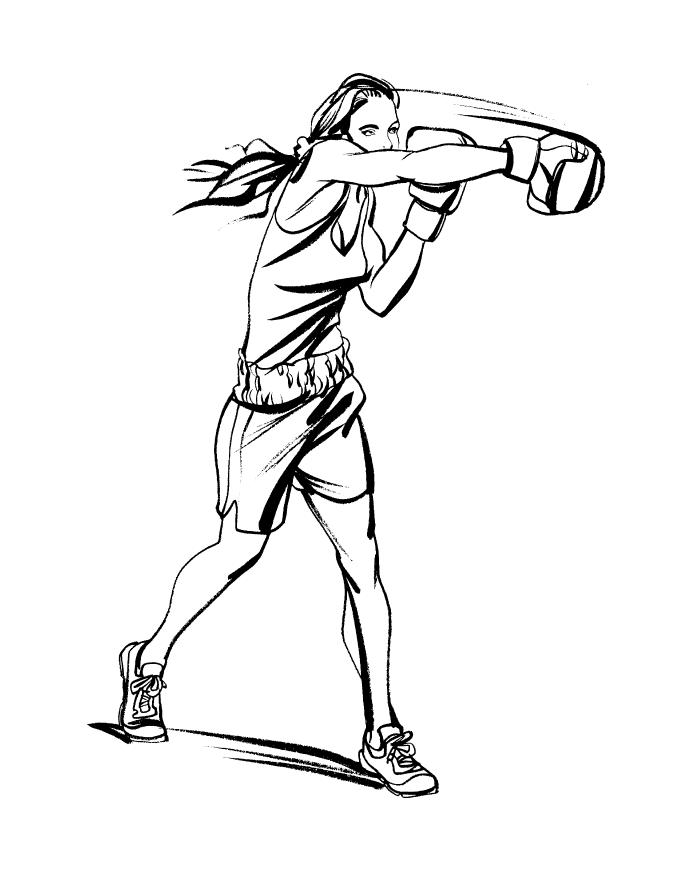
Contents

Foreword
I remember getting on the subway at the corner of Eighth Avenue and Fourteenth Street and getting off at High Street in Brooklyn on my way to Gleasons. The ride over was always filled with excitement over what my day at the gym would bring. What obstacle would I face? What challenge would Hector present me with? What would my mind and body have to overcome?
Walking through the doors of the gym brought a rush of adrenaline that I knew would carry me through whatever would be thrown at meliterally.
At Gleasons, I worked, cried, laughed, fell, got up, sweated, lost bad weight, gained good weight, got punched, punched back. And every day when I walked out of those doors and got back on the subway, I knew a little bit more about myself and what I was capable of. It was more than I ever knew to dream.
I wish the same for you.
Hilary Swank
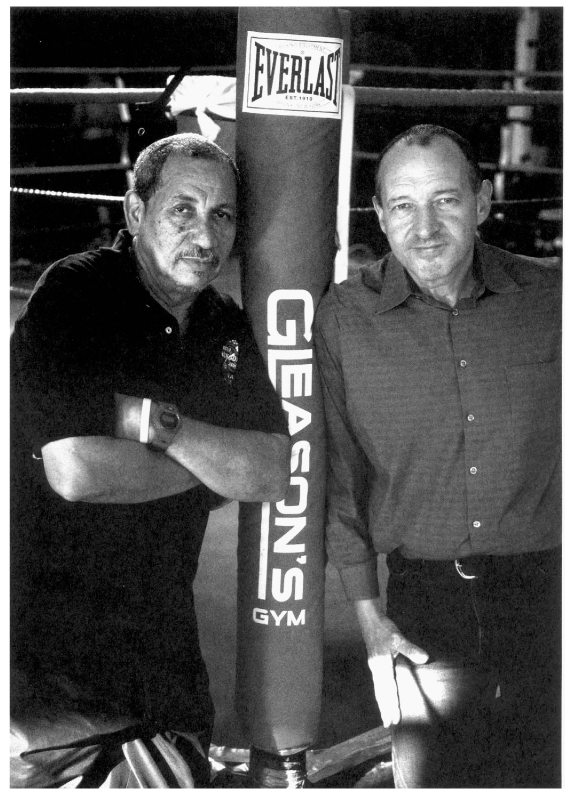
Introduction
THE HISTORY OF GLEASONS GYM
Bruce Silverglade, owner
In the South Bronx, during the Great Depression, boxing was known as an Irishmans sport, which is why a little-known Italian bantamweight named Peter Robert Gagliardi changed his name to Bobby Gleason before opening the doors of his boxing gym in 1937.
For $50 a month, Gleason, forty-five, rented a decrepit but sunny second-floor loft in an old factory building on the corner of 149th Street and Westchester Avenue. Looking out its eight-foot windows, the fighters could see the Royal Theater, where vaudeville stars, including Sophie Tucker, performed; the Central Theater, where neighborhood kids could buy a candy bar and catch a triple feature for a dime; and the Bronx Opera House, the neighborhoods grand dame.
Dues at the gym were $2 a month, and Gleason put up a tough front when it came to collecting them. He hung a sign in his office that read, Your dues are due today. If they have not been paid, please do so and save yourself the embarrassment of being asked. Despite the notice, he let many of his struggling fighters slide for months. Barely able to afford the gym himself, Gleason hacked a cab for ten to twelve hours a night, seven days a week.
With his savings, Gleason outfitted the place with four heavy bags, six racks to hang speed bags (fighters had to bring their own), and a full-sized ring surrounded by chairs for spectators. The locker rooms consisted of one toilet and two showers, which only worked in the winter. (In the summer, the neighborhood kids would cool off by running through the water that came from the city fire hydrants, which sapped the gyms water pressure.) Summer, you can imagine, was not easy on the nose.
Despite its quirks, Gleasons quickly became home to a deep roster of world champions, including Jake Raging Bull LaMotta; Mike Belloise; Phil Terranova, who Gleason managed; and Jimmy Carter. Thanks to their charisma, boxings popularity surged, and Gleasons reputation for turning out top contenders grew. Six days a week, morning until night, the great trainers of the dayPatty Colovito, Freddie Brown, Chickie Ferrara, and Charlie Galetaplied their craft insideand the crowds followed. There was never a still punching bag or free space left on the floor for shadowboxing or skipping rope. The wait to get into the ring, which was first-come, first-serve, often topped out at nearly two hours.
Throughout the forties and fifties, Gleasons, as well as two of the citys other boxing institutions, Stillmans and the Old Garden, flourished, but by the sixties, Boxings Golden Age had ended. With no attention-grabbing boxers, the sports popularity receded. Bobby Gleason managed to hang onto his gym, while Stillmans and the Old Garden went down for the count.
Gleasons remained the permanent training base for many world champs, and many out-of-town contenders, including Walter Cartier and Joe Frazier, set up their temporary base in the Bronx when they had fights scheduled at Madison Square Garden. In 1964, Muhammad Ali, then known as Cassius Clay, trained at Gleasons for his fight with Sonny Liston. (That fight was one of the biggest upsets of the twentieth century; Ali won the World Heavyweight title when Liston failed to answer the bell in the seventh round.) Later, Panamanian superman Roberto Duran used Gleasons to win three world titles. When Duran was at the gym, so seemingly was the rest of New York. Oftentimes, the surrounding street would have to be blocked off to accommodate all of his fans.
In 1974, after thirty-seven years on Westchester Avenue, Bobby Gleason, then eighty-two, put a lock on the Bronx gym door for good. The building was knocked down, and a housing project was constructed in its place. Gleason moved his establishment to Thirtieth Street and Eighth Avenue in Manhattan, and renowned trainers Ray Arcel, Freddy Brown, and Whitey Bimstein followed him to the new location. It was the first street-level gym in New York City. It came well-equipped with an L-shaped mezzanine for the crowds, two training rings, six heavy bags, separate rooms for shadowboxing and skipping rope, and even a luncheonette.
Next page







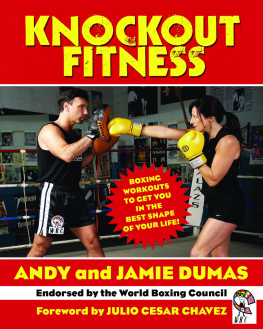

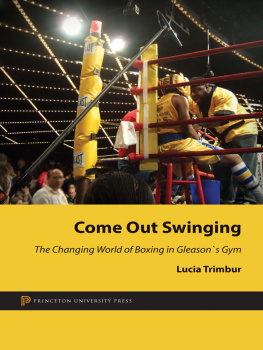
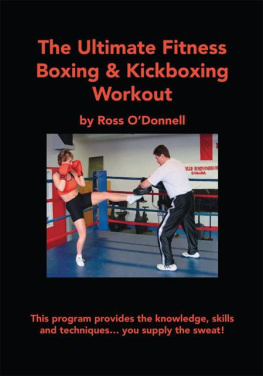





 I want to dedicate this workout book to Gleasons Gym and its wonderful tradition and history.
I want to dedicate this workout book to Gleasons Gym and its wonderful tradition and history.

